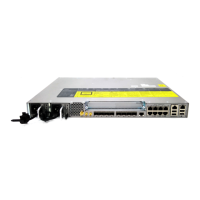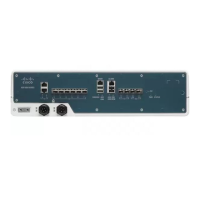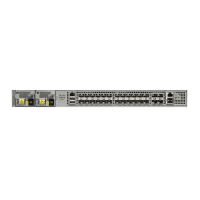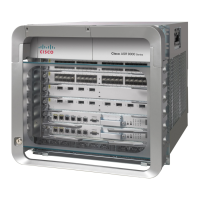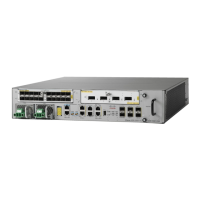Router (config-if-srv)# encapsulation dot1q 960
Router (config-if-srv)# rewrite ingress tag translate 1-to-1 dot1q 965 symmetric
Router (config-if-srv)# bridge-domain 965
For 2-to-1 VLAN translation configuration:
Router (config)# interface gigabitethernet0/2
Router (config-if)# service instance 967 ethernet
Router (config-if-srv)# encapsulation dot1q 962 second-dot1q 963
Router (config-if-srv)# rewrite ingress tag translate 2-to-1 dot1q 967 symmetric
Router (config-if-srv)# bridge-domain 967
Example for Ingress Mapping of C-CoS to S-CoS
S-CoS is marked with the S-CoS value when the packet is matched with the C-CoS value at ingress. In the
following example, GigabitEthernet 0/1 is the ingress interface and GigabitEthernet 0/3 is the egress interface.
This classification is done at the ingress interface and the S-CoS value is set at 4.
policy-map policy-dscp
class class-dscp/customer-cos
set cos 4
interface GigabitEthernet0/1-> Input interface with EVC Push and policy on EVC
service instance 1 ethernet
encapsulation untagged
rewrite ingress tag push dot1q 10
service-policy input policy-dscp
bridge-domain 20
interface GigabitEthernet0/3
service instance 1 ethernet
encapsulation dot1q 30
bridge-domain 20
Example for Ingress Mapping of C-CoS to C-CoS
In the following example, both C-CoS and S-CoS are configured with CoS=4. The example also illustrates
the ingress mapping of C-DSCP or C-CoS to C-CoS, where CoS is marked for both S-CoS and C-CoS.
policy-map policy-dscp
class class-dscp/customer-cos
set cos 4 -> This sets the value of S-CoS.
interface GigabitEthernet0/1 ->Input interface with EVC Push and EVC policy
service instance 1 ethernet
encapsulation untagged
rewrite ingress tag push dot1q 10
service-policy input policy-dscp
bridge-domain 20
interface GigabitEthernet0/3
service instance 1 ethernet
encapsulation dot1q 30
rewrite ingress tag pop1 symmetric
bridge-domain 20
Carrier Ethernet Configuration Guide (Cisco ASR 920 Series)
33
Ethernet Virtual Connections Configuration
Configuring IEEE 802.1Q Tunneling and Layer 2 Protocol Tunneling Using EFPs
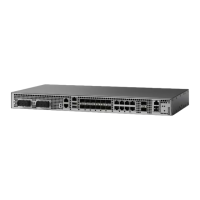
